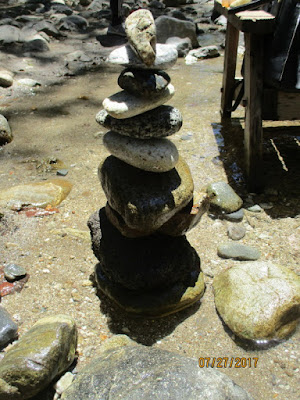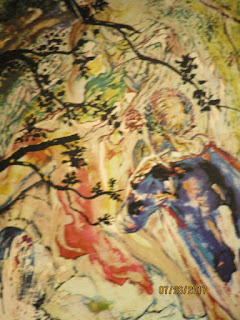Downtown Monterey has a new museum, located where the old Maritime Museum once resided:
Jayne and I spent an afternoon there.
Dali17 is a permanent exhibition of remarkable and unprecedented art, including original etchings, mixed media, lithographs, and rare sculptures by one of the twentieth century's premier and most celebrated surrealist artists, Spaniard Salvador Dali.
The name Dali17 ties Dali's influence and history to the original 17 Mile Drive (through Pebble Beach) where he lived and worked. This is the first permanent Dali exhibition located on the West Coast and the largest private collection on exhibition in the U.S. It has previously been exhibited in Spain and Belgium.
Salvador Dali and his wife fled France in 1940, arrived on the Monterey Peninsula shortly before Pearl Harbor, and found refuge at the Del Monte Hotel. They stayed on the Peninsula for a decade, during which time Dali completed his memoir, "The Secret Life of Salvador Dali."
Throughout the 1940s Dali was involved in the local social art scene.
Monterey was the only place in the U.S. where Salvador Dali lived and painted.
This exhibition centers around the premise to revive Dali's life story by showcasing his influence locally and capturing the rich history that ties him to the Monterey region.

Salvador Dali, surrealist, eccentric artist, creator of melting clocks. Many are familiar with the iconic figure but not everyone knows the person, Salvador Dali.
Salvador Dali was born twice. The first Salvador was born October 21, 1901 in Figueres, Spain and the second on May 11, 1904, in the shadow of his older brother's death. The death of his older brother and namesake would encircle the identity of the second Dali whose life had already begun as an attempt to mirror the image of his older brother.
An intelligent and gifted child, Dali was the center of attention in his family. The early tragedy and lavish attention helped to grow young Dali's excessive behavior. He often exhibited temper tantrums and acted in ways that grew from a desire to receive more attention.
Dali pursued many artistic endeavors--he was a painter, sculptor, filmmaker, actor, set designer, inventor, and writer. He died January 23, 1989. The artist created some of the century's most iconic and important art by capturing a timeless ethos that continues to be interesting and relevant today. He changed the world through his art that challenged convention and society's sense of the normal and reality.
The Spirit is Willing but the Flesh is Weak
This is my Blood of the Covenant

Locusts and Caterpillars
Joshua, Brave in War
Anthony and Cleopatra, 1979
"In this great symbolic work we see life and love portrayed in the figures of Anthony and Cleopatra, the great classical lovers. They are depicted in the foreground of the great Roman Forum--shown as empty and abandoned as their life apart was to be.
Lancelot and Guinevere, 1979
In this final symbolic work we see the culmination of life and love portrayed in the figures of Lancelot and Guinevere. They are depicted in the secret woodland glades of imagination and desire.
Nowhere do we find a more powerful and romantic idealization of love than in this final great work of Dali's.
Persistence de la Memoire
One of Dali's most famous works, the painting of the Persistence of Memory is a masterpiece. The iconic melting clocks are symbolic of Dali's psychological neuroses, such as his hatred of soft objects. The vision of a melting clock actually appeared to Dali after eating Camembert cheese that had turned soft and gooey. The use of a clock also represents memories and how the timepieces consciously document moments from past events.
The following series has been interpreted as a symbol of the absurdity of human existence in the modern world.
The Swallow or The Defeat of Civilization--1976
The Atomic Era
In 1936, Dali designed the cover of the French surrealist magazine, Minotaurs. Using his paranoiac-critical method, the artist used open drawers and the figure of a posing woman to express his obsession with consumerism.
Space Elephant--1960
The elephant is a recurring theme that appears in several of Dali's paintings and reveals Dali's interest in the mystical. His fascination with the atomic bomb led Dali to choose subjects he considered spiritual and filled with power.
Space Elephant appears small and fragile, yet its frail and skeletal legs inexplicably support the crushing weight of the obelisk.
As usual I found Dali's work to be often amusing, sometimes ridiculous and usually captivating. In addition, I think the interpretations of his paintings are as bloviated as what some waiter might robotically recite about the wine or dinner specials in a 5-star restaurant. I refrained from copying the more overdone descriptions. I saw the Dali Museum in St Petersburg, Fla and admit that I enjoyed both. I do stand in awe of anyone who lives his/her life without limits and Dali did that.
The museum also has a theatre playing films all day about Dali and his wife. One film is called "Dirty Dali" about his sex life and, of course, we had to see it. Did I say 'life without limits'? He had such a life.
(All Italics from the museum materials)






























































